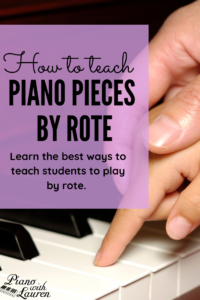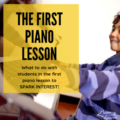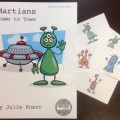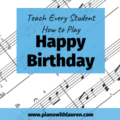Piano teachers all around the world are talking about “rote” pieces. It has been a big trend in piano teaching the last few years.
While there was a time when teaching by rote (teacher plays and student mimics), was considered less than, this style of teaching has come back and become very popular again.
Using a combination of note-reading and rote playing is a great blended approach to teaching piano. Students will still learn how to read music (fostering greater independence for long-term playing), but also playing by rote will develop the student’s ear, musicality, and confidence.
Having a set of 4-5 memorized pieces that are learned by rote is a great way to boost the confidence of students. Students will want to share their music with whoever will listen.
If you are new to incorporating this style of teaching into your studio, here are some tips for teaching piano pieces by rote.
LISTEN
First and foremost, the student needs to listen to the piece. Play the piece for the student at the very beginning of his lesson. You can even play it several times for the student a week or two before teaching it.
Make sure the student has a way to listen to the piece outside of his or her lesson. You can:
- Find the video on YouTube (such as Piano Safari reminder videos).
- Send the student home with a CD.
- Create an audio recording in the lesson using the student’s electronic device.
- Create a video recording in the lesson using the parent’s cell phone.
- Create your own video or audio recording for the student and share it with the parent on Dropbox, Vimeo, or YouTube.
BREAK IT DOWN
Unless it is a very short piece, do not attempt to teach the entire piece to a student in one lesson. Teach the student one little section. Then add to it each week. To break down a rote piece, you can:
- Teach the piece phrase-by-phrase. Do not add on another phrase until the student has absolutely mastered one phrase.
- If the piece requires hands together playing, teach one hand at a time for each section before putting together.
- You can teach one section of a piece each week until the student has the entire piece mastered.
REPETITION
Besides listening, the most important aspect of teaching by rote is to make sure students play the piece *a lot*!
Start the lesson with the rote piece. The come back to the rote piece in the middle of the lesson and then again at the end of the lesson.
It is very important that students play the piece many, many times during the lesson to secure it before going home. If not, they may not remember it once they leave your studio.
If the repetition gets boring for the student, have him or her play the rote piece in different octaves. Young students love to explore the range of the piano. They will hear what the piece sounds like in different registers.
VISUALIZE
As you teach the piece, you can create a roadmap on paper of the different sections of their piece. Put a short description of each section so that the student will be able to see the form of the piece.
Once a student has mastered the rote piece, you can also show him the piece in his book. The student will see what the patterns on the piano look like on the score.
Older students who might be learning by rote, can use a blended approach of using the sheet music in addition to audio and visual aids.
You might feel like this is cheating! As with spoken languages, it’s important to hear the language spoken while learning to speak it. Music is the same way- make sure your students have plenty of opportunity to listen to their music.
REVIEW
Keep a list of all the memorized pieces that your student has. Review these throughout the year! It will be a great success for your student to have at least 5-10 memorized pieces.
Lauren teaches piano to students of all ages. She enjoys creating resources for her students and teachers. She is the author of Ready for Theory®. For personalized help, check out the consultations page for teachers.






